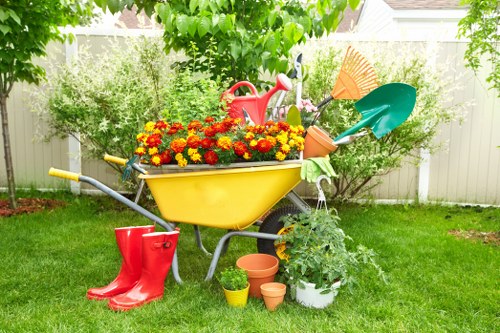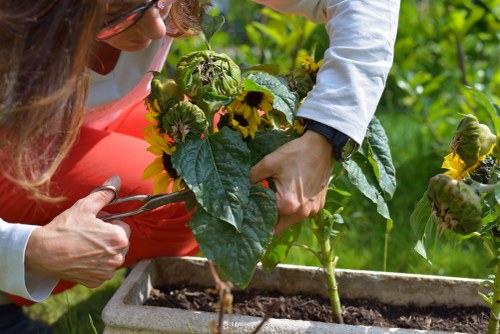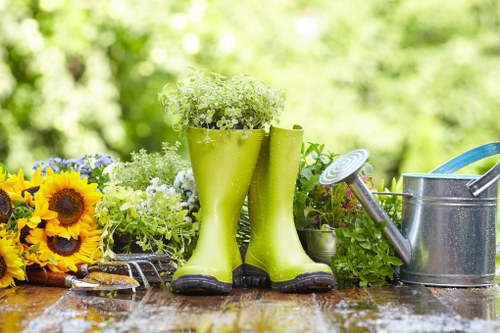Gardener Poplar

Poplar trees are a fantastic addition to any garden, offering both beauty and functionality. As a gardener, understanding the different types of poplars and how to care for them can elevate your gardening experience. Poplars are known for their rapid growth, making them ideal for creating natural screens or providing quick shade.
These trees are native to various regions and come in multiple species, each with its unique characteristics. Whether you're looking to add height to your garden or create a serene environment, poplars can be an excellent choice.
In this article, we'll explore the different types of poplar trees, their benefits, care tips, and how they can enhance your garden's aesthetic and ecological value.
Types of Poplar for Gardening

White Poplar
The White Poplar is one of the most popular species among gardeners. It features tall, straight trunks with light green leaves that turn yellow in the fall. This tree can grow up to 50 feet tall, making it a great choice for creating natural boundaries or windbreaks.
White Poplars are relatively easy to care for and adapt well to different soil types. They thrive in full sunlight but can tolerate partial shade, making them versatile for various garden settings.
Additionally, their fast growth rate means you'll enjoy the benefits of a large, leafy tree in a shorter period compared to other species.
Lombardy Poplar

The Lombardy Poplar is renowned for its narrow, columnar shape, making it perfect for tight spaces or as a visually appealing vertical element in your garden. This poplar can reach heights of up to 70 feet, with a swift growth rate that provides quick screening.
Its dense foliage offers excellent privacy, and the tree's symmetrical form adds a touch of elegance to any landscape. However, Lombardy Poplars require regular maintenance to keep their shape and prevent any potential structural issues.
They are best planted in areas where straight growth is encouraged, and adequate space is available to accommodate their height.
Eastern Cottonwood

The Eastern Cottonwood is a robust species known for its large size and heart-shaped leaves. Growing up to 80 feet tall, this poplar is ideal for vast gardens and parks. Its extensive root system helps in stabilizing the soil, making it beneficial for preventing erosion.
Eastern Cottonwoods prefer moist soil conditions and are commonly found near water sources. They provide ample shade and have a majestic presence, enhancing the overall landscape's grandeur.
Despite their size, Cottonwoods are relatively low-maintenance once established, requiring minimal pruning and care.
How to Plant and Care for Poplar Trees

Planting Location
Choosing the right location for your poplar tree is crucial. Poplars thrive in areas with full sunlight to partial shade. Ensure the site has ample space for the tree to grow both vertically and horizontally.
Avoid planting poplars too close to buildings or underground utilities, as their extensive root systems can cause damage over time. Adequate spacing also allows for proper air circulation, reducing the risk of diseases.
Consider the mature size of the tree to ensure it fits well within your garden without overcrowding other plants or structures.
Watering and Soil Requirements
Poplar trees prefer well-drained soil rich in organic matter. Before planting, amend the soil with compost to enhance fertility and drainage. Regular watering is essential, especially during the first few years as the tree establishes its root system.
While poplars are relatively drought-tolerant once mature, consistent moisture helps in promoting healthy growth and vibrant foliage.
Avoid overwatering, as it can lead to root rot and other fungal issues. Mulching around the base can help retain soil moisture and regulate temperature.
Pruning and Maintenance
Regular pruning aids in maintaining the tree's shape and removing any dead or diseased branches. For species like the Lombardy Poplar, pruning is essential to preserve their columnar form.
Prune during the dormant season to minimize stress on the tree. Start by removing any crossing branches and thinning out the canopy to allow light penetration.
Proper maintenance not only enhances the tree's appearance but also ensures its longevity and health.
Benefits of Poplar Trees in Gardens
Environmental Advantages
Poplar trees play a significant role in improving the environment. They absorb carbon dioxide and release oxygen, contributing to better air quality. The extensive root systems help in preventing soil erosion and enhancing soil structure.
Wildlife Support
These trees provide habitat and food for various wildlife species. Birds often nest in poplar branches, and the trees attract pollinators like bees and butterflies, promoting biodiversity in your garden.
Aesthetic Appeal
With their tall stature and vibrant foliage, poplars add a striking visual element to any garden. Their seasonal changes, from lush green leaves to colorful autumn hues, offer year-round beauty.
Common Issues and Troubleshooting
While poplars are generally resilient, they can be susceptible to certain pests and diseases. Common issues include:
- Leaf Spot Diseases: Fungal infections that cause discoloration and spots on leaves.
- Poplar Borer: Insect pests that tunnel into the wood, weakening the tree structure.
- Powdery Mildew: A fungal disease that affects the surface of leaves, leading to a white, powdery appearance.
Regular inspections and prompt treatment can help manage these issues effectively. Implementing good cultural practices, such as proper spacing and adequate watering, also reduces the risk of diseases.
In severe cases, consulting a professional arborist may be necessary to ensure the tree's health and safety.
Local Relevance: Nearby Areas to Poplar
For gardeners in the vicinity of Poplar, several nearby areas offer unique features and benefits:
- Maple Grove: Located just 5 miles from Poplar, Maple Grove is renowned for its vibrant fall foliage and extensive maple tree orchards.
- Oakwood Park: 8 miles away, this park provides vast open spaces perfect for picnics and leisurely walks under towering oak trees.
- Pine Ridge: Situated 10 miles from Poplar, Pine Ridge is known for its dense pine forests and hiking trails.
- Birch Valley: 12 miles away, Birch Valley features serene birch-lined waterways and scenic viewpoints.
- Cedar Springs: Just 7 miles from Poplar, Cedar Springs offers beautiful cedar trees and natural springs, ideal for relaxation and reflection.
- Willow Creek: 9 miles away, Willow Creek is famous for its graceful willow trees and peaceful creekside paths.
- Spruce Hill: Located 6 miles from Poplar, Spruce Hill boasts robust spruce trees and challenging trails for avid hikers.
- Elmwood: 11 miles away, Elmwood is home to mature elm trees and historic landmarks, adding cultural value to the natural landscape.
- Redwood Meadows: 14 miles from Poplar, Redwood Meadows features majestic redwood trees and expansive meadows perfect for outdoor activities.
- Cherry Blossom Park: 13 miles away, this park is celebrated for its beautiful cherry blossoms that bloom each spring, attracting visitors from all around.
Conclusion
Poplar trees are a valuable asset to any garden, offering a blend of aesthetic beauty and environmental benefits. Their rapid growth and versatility make them suitable for various landscaping needs, from creating privacy screens to enhancing biodiversity.
By understanding the different types of poplars and implementing proper care practices, gardeners can enjoy the numerous advantages these trees bring. Whether you're planting a White Poplar for quick shade or a Lombardy Poplar for its elegant form, poplars can significantly contribute to a thriving and beautiful garden.
Frequently Asked Questions

1. How fast do poplar trees grow?
Poplar trees are known for their rapid growth, often adding 3 to 8 feet annually under optimal conditions. This makes them a popular choice for quickly establishing shade or privacy screens.
2. Are poplar trees suitable for small gardens?
Yes, certain species like the Lombardy Poplar with its narrow growth habit are ideal for small gardens. It's important to select the right variety and provide adequate space to accommodate their mature size.
3. Do poplar trees require a lot of maintenance?
Poplar trees generally require minimal maintenance. Regular watering during the establishment phase, occasional pruning to maintain shape, and monitoring for pests or diseases are usually sufficient.
4. Can poplar trees improve soil quality?
Yes, poplar trees have extensive root systems that help in preventing soil erosion and improving soil structure. Additionally, their leaves can contribute to organic matter when they decompose.
5. Are poplar trees resistant to pests?
While poplar trees are relatively resilient, they can be susceptible to certain pests like poplar borers and diseases such as powdery mildew. Regular monitoring and timely interventions can help manage these issues effectively.
Frequently Asked Questions
Pruning poplar trees in Spring helps promote healthy growth and shape. Our Poplar gardeners use specialized hedge trimmers and follow best practices to remove dead or overgrown branches. This ensures your trees remain strong and vibrant. Contact our experienced team in Poplar for expert pruning services tailored to your garden’s needs.
Finding licensed gardeners in Poplar is easy with our trusted services. Our team is fully accredited and certified, ensuring professional maintenance for your poplar trees. We have over a decade of experience maintaining local estates. Reach out to our Poplar experts today to schedule a consultation and keep your trees in top condition.
Yes, we offer eco-friendly weed control solutions for poplar gardens in Poplar. Our methods use sustainable practices and non-toxic treatments to keep your garden healthy without harming the environment. Protect your poplar trees and enhance your garden’s beauty with our green weed control services. Contact us today to learn more.
A professional poplar gardener in Poplar should hold certifications from recognized bodies like the Royal Horticultural Society (RHS) or BALI. Our team is fully accredited and licensed to handle all aspects of poplar tree care, including pesticide application and public liability insurance. Trust our certified experts to provide top-quality maintenance for your poplar trees.
Yes, our garden clearance services for poplar trees in Poplar are competitively priced to suit various budgets. We offer comprehensive clearance that ensures your garden remains tidy and safe. With transparent pricing and no hidden fees, you can trust us to provide affordable and efficient clearance services. Contact our Poplar team for a free, tailored quote today.
Professionals use high-quality hedge trimmers and ride-on mowers for efficient hedge trimming around poplar trees. Our Poplar gardeners are equipped with the latest tools to ensure precise and clean cuts, promoting healthy growth and aesthetics. Trust our experienced team to maintain your hedges expertly. Get in touch with our Poplar specialists for top-notch trimming services.
Our gardeners in Poplar have over 10 years of experience specializing in poplar tree care. They are trained in advanced maintenance techniques, ensuring your trees remain healthy and beautifully landscaped year-round. With a deep understanding of poplar tree needs, our experts provide reliable and professional services. Contact us to benefit from our extensive experience.
We offer comprehensive seasonal services for maintaining poplar trees in Poplar, including spring pruning, summer watering, autumn leaf clearance, and winter protection. Our experienced team ensures your trees thrive through every season with tailored care plans. Keep your poplar trees healthy and attractive year-round by scheduling seasonal maintenance with our trusted Poplar gardeners today.
Yes, our poplar gardening services in Poplar are fully insured with public liability coverage. This ensures peace of mind knowing that our team is protected and your property is safeguarded during all gardening activities. Our commitment to safety and professionalism makes us a trusted choice for poplar tree care. Contact us to learn more about our insured services.
To ensure reliable lawn prep services for your poplar garden, choose our experienced team in Poplar. We use top-grade equipment and proven techniques to prepare your lawn for optimal growth, including soil testing, aeration, and fertilization. Our dependable services guarantee a lush, healthy lawn that complements your poplar trees. Reach out to our Poplar gardeners for dependable lawn preparation.
Our full poplar tree maintenance package includes pruning, pest and disease control, soil health management, and regular inspections. We use eco-friendly methods and state-of-the-art equipment to ensure your poplar trees remain healthy and beautiful. With over a decade of experience, our Poplar team provides comprehensive care tailored to your garden’s needs. Contact us to customize your maintenance package today.
For trusted garden landscaping services near you in Poplar, our local team is the perfect choice. We specialize in designing and maintaining beautiful landscapes featuring poplar trees, using professional equipment and eco-friendly practices. With a strong reputation and years of experience, we deliver exceptional results tailored to your vision. Get in touch with our Poplar landscaping experts to transform your garden.






